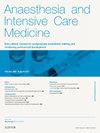Capillary dynamics, interstitial fluid and the lymphatic system
IF 0.2
Q4 ANESTHESIOLOGY
引用次数: 0
Abstract
The regulation of small blood vessels (arterioles, venules and capillaries) and the formation of interstitial fluid at the capillary beds is an important process in the understanding of the healthy circulation. Traditionally, Starling's forces have been at the very heart of our understanding of this system. However, more recent work shows that the transvascular fluid flux is significantly lower than what one would expect on the basis of Starling’s forces alone, and hence alternative explanations have been sought to understand the process of tissue fluid formation. In this context the role of the endothelial glycocalyx layer (or EGL) has drawn substantial interest. The EGL is a dynamic, active interface between the blood and the endothelial cells. It is formed by membrane-bound glycoproteins, proteoglycans and polysaccharides, producing a hydrated gel-like layer on the luminal surface of the vascular endothelium of approximately 500–2000 nm thickness. In this paper we review some of these emerging concepts and propose alternative ideas to understand some frequent clinical conditions and their treatment.
求助全文
约1分钟内获得全文
求助全文
来源期刊

Anaesthesia and Intensive Care Medicine
ANESTHESIOLOGY-
CiteScore
0.50
自引率
0.00%
发文量
152
期刊介绍:
Anaesthesia and Intensive Care Medicine, an invaluable source of up-to-date information, with the curriculum of both the Primary and Final FRCA examinations covered over a three-year cycle. Published monthly this ever-updating text book will be an invaluable source for both trainee and experienced anaesthetists. The enthusiastic editorial board, under the guidance of two eminent and experienced series editors, ensures Anaesthesia and Intensive Care Medicine covers all the key topics in a comprehensive and authoritative manner. Articles now include learning objectives and eash issue features MCQs, facilitating self-directed learning and enabling readers at all levels to test their knowledge. Each issue is divided between basic scientific and clinical sections. The basic science articles include anatomy, physiology, pharmacology, physics and clinical measurement, while the clinical sections cover anaesthetic agents and techniques, assessment and perioperative management. Further sections cover audit, trials, statistics, ethical and legal medicine, and the management of acute and chronic pain.
 求助内容:
求助内容: 应助结果提醒方式:
应助结果提醒方式:


